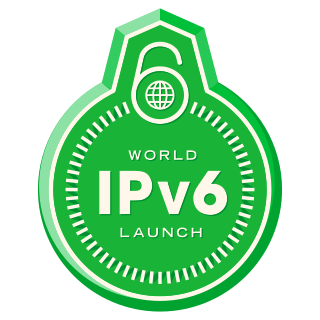Related Research Articles

Internet Protocol version 4 (IPv4) is the fourth version of the Internet Protocol (IP). It is one of the core protocols of standards-based internetworking methods in the Internet and other packet-switched networks. IPv4 was the first version deployed for production on SATNET in 1982 and on the ARPANET in January 1983. It is still used to route most Internet traffic today, even with the ongoing deployment of Internet Protocol version 6 (IPv6), its successor.

Internet Protocol version 6 (IPv6) is the most recent version of the Internet Protocol (IP), the communications protocol that provides an identification and location system for computers on networks and routes traffic across the Internet. IPv6 was developed by the Internet Engineering Task Force (IETF) to deal with the long-anticipated problem of IPv4 address exhaustion, and is intended to replace IPv4. In December 1998, IPv6 became a Draft Standard for the IETF, which subsequently ratified it as an Internet Standard on 14 July 2017.
A virtual private network (VPN) extends a private network across a public network and enables users to send and receive data across shared or public networks as if their computing devices were directly connected to the private network. The benefits of a VPN include increases in functionality, security, and management of the private network. It provides access to resources that are inaccessible on the public network and is typically used for remote workers. Encryption is common, although not an inherent part of a VPN connection.

Number 5 Squadron was a squadron of the Royal Air Force. It most recently operated the Raytheon Sentinel R1 Airborne STand-Off Radar (ASTOR) aircraft from RAF Waddington, Lincolnshire, between April 2004 until March 2021.
Mobile IP is an Internet Engineering Task Force (IETF) standard communications protocol that is designed to allow mobile device users to move from one network to another while maintaining a permanent IP address. Mobile IP for IPv4 is described in IETF RFC 5944, and extensions are defined in IETF RFC 4721. Mobile IPv6, the IP mobility implementation for the next generation of the Internet Protocol, IPv6, is described in RFC 6275.
In computer networking, Teredo is a transition technology that gives full IPv6 connectivity for IPv6-capable hosts that are on the IPv4 Internet but have no native connection to an IPv6 network. Unlike similar protocols such as 6to4, it can perform its function even from behind network address translation (NAT) devices such as home routers.
In the context of computer networking, a tunnel broker is a service which provides a network tunnel. These tunnels can provide encapsulated connectivity over existing infrastructure to another infrastructure.
Anything In Anything (AYIYA) is a computer networking protocol for managing IP tunneling protocols in use between separated Internet Protocol networks. It is most often used to provide IPv6 transit over an IPv4 network link when network address translation masquerades a private network with a single IP address that may change frequently because of DHCP provisioning by Internet service providers.

IPv4 address exhaustion is the depletion of the pool of unallocated IPv4 addresses. Because the original Internet architecture had fewer than 4.3 billion addresses available, depletion has been anticipated since the late 1980s, when the Internet started experiencing dramatic growth. This depletion is one of the reasons for the development and deployment of its successor protocol, IPv6. IPv4 and IPv6 coexist on the Internet.
AICCU was a popular cross-platform utility for automatically configuring an IPv6 tunnel. It is free software available under a BSD license. The utility was originally provided for the SixXS Tunnel Broker but it can also be used by a variety of other tunnel brokers.
6in4 is an IPv6 transition mechanism for migrating from Internet Protocol version 4 (IPv4) to IPv6. It is a tunneling protocol that encapsulates IPv6 packets on specially configured IPv4 links according to the specifications of RFC 4213. The IP protocol number for 6in4 is 41, per IANA reservation.
In computer networking, the Tunnel Setup Protocol (TSP) is an experimental networking control protocol used to negotiate IP tunnel setup parameters between a tunnel client host and a tunnel broker server, the tunnel end-points. A major use of TSP is in IPv6 transition mechanisms.
An IPv6 transition mechanism is a technology that facilitates the transitioning of the Internet from the Internet Protocol version 4 (IPv4) infrastructure in use since 1983 to the successor addressing and routing system of Internet Protocol Version 6 (IPv6). As IPv4 and IPv6 networks are not directly interoperable, transition technologies are designed to permit hosts on either network type to communicate with any other host.
A unique local address (ULA) is an Internet Protocol version 6 (IPv6) address in the address range fc00::/7. Its purpose in IPv6 is analogous to IPv4 private network addressing. Unique local addresses may be used freely, without centralized registration, inside a single site or organization or spanning a limited number of sites or organizations. They are routable only within the scope of such private networks, but not in the global IPv6 Internet.
Deployment of Internet Protocol Version 6 (IPv6), the latest generation of the Internet Protocol, has been in progress since the mid-2000s.

Locator/ID Separation Protocol (LISP) is a "map-and-encapsulate" protocol which is developed by the Internet Engineering Task Force LISP Working Group. The basic idea behind the separation is that the Internet architecture combines two functions, routing locators and identifiers in one number space: the IP address. LISP supports the separation of the IPv4 and IPv6 address space following a network-based map-and-encapsulate scheme. In LISP, both identifiers and locators can be IP addresses or arbitrary elements like a set of GPS coordinates or a MAC address.
Hurricane Electric is a global Internet service provider offering internet transit, tools, and network applications, as well as data center colocation and hosting services at 2 locations in Fremont, California, where the company is based.
4in6 refers to tunneling of IPv4 in IPv6. It is an Internet interoperation mechanism allowing Internet Protocol version 4 (IPv4) to be used in an IPv6 only network. 4in6 uses tunneling to encapsulate IPv4 traffic over configured IPv6 tunnels as defined in RFC 2473. 4in6 tunnels are usually manually configured but they can be automated using protocols such as TSP to allow easy connection to a tunnel broker.

World IPv6 Day was a technical testing and publicity event in 2011 sponsored and organized by the Internet Society and several large Internet content services to test and promote public IPv6 deployment. Following the success of the 2011 test day, the Internet Society carried out a World IPv6 Launch day on June 6, 2012 which, instead of just a test day, was planned to permanently enable IPv6 for the products and services of the participants.
Pakistan Armed Forces deployments include all Pakistani military deployments that are stationed outside Pakistan and serving in other countries. The sixth largest military power in terms of active troops, Pakistan has an extensive history of overseas military presence, especially in the Middle East, where it has maintained military contingents, missions and battalions in several states. As part of its foreign policy efforts to expand its military relations and influence in the region, Pakistan signed defence protocols during the 1970s with several Arab countries including Saudi Arabia, Libya, Jordan, Iraq, Oman, the United Arab Emirates and Kuwait, under which members of the armed forces of these countries were imparted professional training by Pakistani advisers and military trainers. Saudi Arabia signed a bilateral agreement with Pakistan on defense cooperation; during that time, there were 50,000 to 60,000 Pakistani military personnel serving abroad with the largest number of these, about 20,000, deployed in Saudi Arabia.
References
- ↑ "6project Policy". 6project. Archived from the original on 2018-04-05. Retrieved 2017-01-28.
- ↑ "AARNet IPv6 Migration Broker experimental service". AARnet mailinglist. 12 November 2003. Retrieved 3 May 2016.
- ↑ "Saudi Arabia IPv6 Task Force - 9th task force meeting". Saudi Arabia IPv6 Task Force. 10 October 2010. Retrieved 3 May 2016.
- ↑ "IPv6 Tunnel Broker Registration". Saudi Arabia IPv6 Task Force. Retrieved 30 January 2016.
- ↑ "CITC IPv6 Tunnel Broker - Saudi Arabia IPv6 Task Force". Ipv6.org.sa. Archived from the original on 9 February 2015. Retrieved 14 December 2014.
- ↑ "Hurricane Electric Free IPv6 Tunnel Broker". Tunnelbroker.net. Retrieved 14 December 2014.
- ↑ "Hurricane Electric Upgrades IPv6 Tunnel Broker". Hurricane Electric. Retrieved 3 May 2016.
- ↑ "Tunnel Server Status". Hurricane Electric. Retrieved 19 May 2017.
- ↑ "HE.net IPv6 Tunnel Broker Registration". Hurricane Electric. Retrieved 30 January 2016.
- ↑ "Dyn-compliant Endpoint Updates". Hurricane Electric. Retrieved 18 December 2015.
- ↑ "IPv6 Now!". IPv6 Now. 1 August 2008. Archived from the original on 4 July 2018. Retrieved 3 May 2016.
- ↑ "Netassist announces Tunnel Broker". NetAssist on Facebook. 5 September 2011. Retrieved 3 May 2016.
- ↑ "NetAssist::IPv6 Tunnel Broker". Netassist.ua. Retrieved 14 December 2014.
- ↑ "History :: SixXS - IPv6 Deployment & Tunnel Broker". SixXS. Retrieved 3 May 2016.
- ↑ "Main :: SixXS" . Retrieved 6 June 2017.
- ↑ "SixXS - IPv6 Deployment & Tunnel Broker :: Points of Presence". Sixxs.net. Retrieved 14 December 2014.
- ↑ "Signup for a -SIXXS handle". SixXS. Retrieved 30 January 2016.
- ↑ "SixXS - IPv6 Deployment & Tunnel Broker :: Points of Presence - All Prefixes". Sixxs.net. Retrieved 14 December 2014.
- ↑ "SixXS - IPv6 Deployment & Tunnel Broker :: Frequently Asked Questions (FAQ)". Sixxs.net. Retrieved 14 December 2014.
- ↑ "draft-massar-v6ops-heartbeat-01 - SixXS Heartbeat Protocol". Tools.ietf.org. Retrieved 14 December 2014.
- ↑ "SixXS - IPv6 Deployment & Tunnel Broker :: Tunnel Information and Control protocol (TIC)". Sixxs.net. Retrieved 14 December 2014.